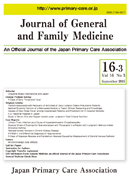Volume 16, Issue 3
Displaying 1-16 of 16 articles from this issue
- |<
- <
- 1
- >
- >|
Editorials
-
Article type: Editorials
2015Volume 16Issue 3 Pages 129-130
Published: September 20, 2015
Released on J-STAGE: October 30, 2015
Download PDF (496K)
Clinical Problem Solving
-
Article type: Clinical Problem Solving
2015Volume 16Issue 3 Pages 131-137
Published: September 20, 2015
Released on J-STAGE: October 30, 2015
Download PDF (679K)
Special Articles
-
Article type: Special Articles
2015Volume 16Issue 3 Pages 138-142
Published: September 20, 2015
Released on J-STAGE: October 30, 2015
Download PDF (64K) -
Article type: Special Articles
2015Volume 16Issue 3 Pages 143-152
Published: September 20, 2015
Released on J-STAGE: October 30, 2015
Download PDF (989K) -
Article type: Special Articles
2015Volume 16Issue 3 Pages 153-157
Published: September 20, 2015
Released on J-STAGE: October 30, 2015
Download PDF (58K) -
Article type: Special Articles
2015Volume 16Issue 3 Pages 158-169
Published: September 20, 2015
Released on J-STAGE: October 30, 2015
Download PDF (615K)
Review Articles
-
Article type: Review Articles
2015Volume 16Issue 3 Pages 170-176
Published: September 20, 2015
Released on J-STAGE: October 30, 2015
Download PDF (113K)
Original Articles
-
Article type: Original Articles
2015Volume 16Issue 3 Pages 177-186
Published: September 20, 2015
Released on J-STAGE: October 30, 2015
Download PDF (463K) -
Article type: Original Articles
2015Volume 16Issue 3 Pages 187-192
Published: September 20, 2015
Released on J-STAGE: October 30, 2015
Download PDF (1379K) -
Article type: Original Articles
2015Volume 16Issue 3 Pages 193-198
Published: September 20, 2015
Released on J-STAGE: October 30, 2015
Download PDF (643K)
Case Reports
-
Article type: Case Reports
2015Volume 16Issue 3 Pages 199-203
Published: September 20, 2015
Released on J-STAGE: October 30, 2015
Download PDF (1150K) -
Article type: Case Reports
2015Volume 16Issue 3 Pages 204-207
Published: September 20, 2015
Released on J-STAGE: October 30, 2015
Download PDF (68K)
Images in Clinical Medicine
-
Article type: Images in Clinical Medicine
2015Volume 16Issue 3 Pages 208-209
Published: September 20, 2015
Released on J-STAGE: October 30, 2015
Download PDF (459K) -
Article type: Images in Clinical Medicine
2015Volume 16Issue 3 Pages 210-212
Published: September 20, 2015
Released on J-STAGE: October 30, 2015
Download PDF (800K) -
Article type: Images in Clinical Medicine
2015Volume 16Issue 3 Pages 213-214
Published: September 20, 2015
Released on J-STAGE: October 30, 2015
Download PDF (789K)
-
Article type: Error and Correction
2015Volume 16Issue 3 Pages 215
Published: September 20, 2015
Released on J-STAGE: October 30, 2015
Download PDF (18K)
- |<
- <
- 1
- >
- >|
